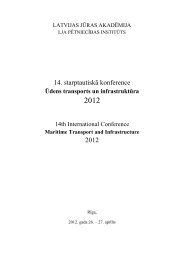You also want an ePaper? Increase the reach of your titles
YUMPU automatically turns print PDFs into web optimized ePapers that Google loves.
Figure 2. Age structure of merchant fleet seafarersSource: author’s calculations based on data obtained from Seamen Registry of <strong>Latvian</strong> <strong>Maritime</strong> AdministrationActive pool consists of seafarers which are employed on board and hold valid STCW certificate.The pool of active seafarers is linked with pool of ex-seafarers as seafarers can leave work on board forseveral years ( when they are considered as ex-seafarers in data) and then go back to work on ships(become active again). Persons can be considered as ex-seafarers who have gained maritime qualificationand are in age group from 20 - 29 years but presently they are not actively employed on board ships anddon’t hold valid STCW certificate. The outflow from active pool to maritime or other industries ashore iscontinuous and linked with external factors such as employment possibilities ashore, economicdevelopment (pull factors) or internal factors such as demand for qualification represented by persons oremployment conditions on board (push factors). As main factors (which influence the attraction ofseafarers and also the outflow to other industries inflow) are often mentioned: opportunities ofemployment ashore, education and the closing gap between salaries on board and ashore, the growth inavailability and ease in procurement of cheap lower crews from low-cost countries. These factors aredirectly related to cost/benefit ratio and therefore can influence growth or decline of number of seafarersin particular country [13]. The employment possibilities for ex-seafarers depend on the size of maritimecluster in the particular country. Traditional employment pathways after work at sea for ex-seafarersdiffers from country to country as it can be seen in research about career paths in maritime industries [14].The main problem in modelling the supply side of seafarers lies in fact that present size of activeseafarers’ pool is influenced by the number of graduates and the attraction of shore industries which hasdifferent impact on different groups of seafarers at different period of time3. Active pool of <strong>Latvian</strong> seafarersTable 1. Size and structure of seafarers’ pool (2013)Total number of seafarers 12,9701) Merchant fleet seafarers: 11,9601.1) Deck department 5650Officers 2500Ratings 31501.2) Engine department: 4890Officers 3040Ratings 18501.3) Catering department (cooks, stewards) 14002) Inland fleet seafarers & personnel of fishing vessels 1010Source: author’s calculations based on data obtained from Seamen Registry of <strong>Latvian</strong> <strong>Maritime</strong> AdministrationComposition of the pool of active <strong>Latvian</strong> seafarers is given in Table 1. 92% of seafarers aremerchant fleet seafarers. 47% of them are classified as deck department seafarers, 41% are classified asengine department seafarers, but 12% are classified as catering departments’ seafarers. The number ofseafarers in Latvia is calculated every year with the reference date 1st January. The base for the number7
















